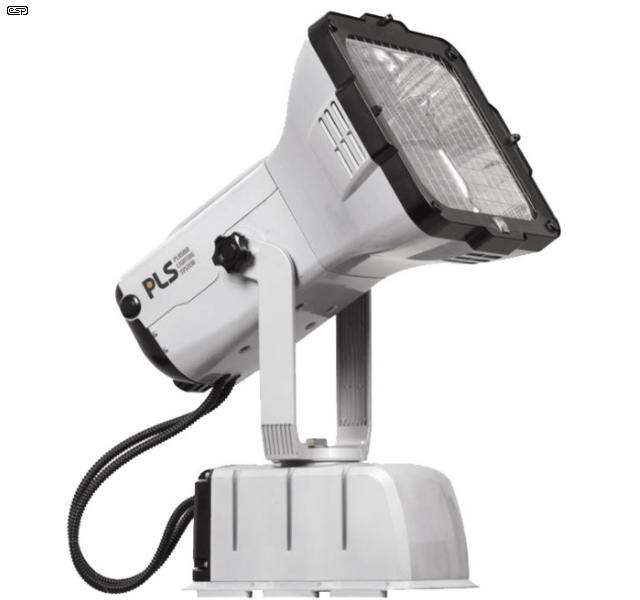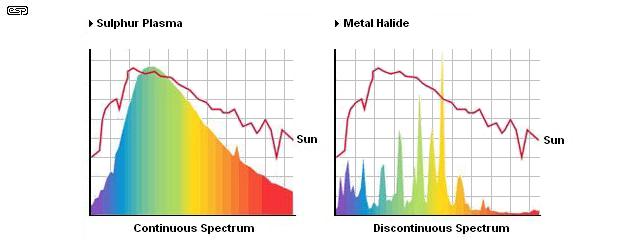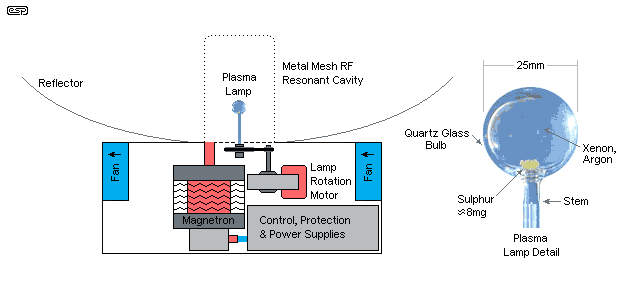

|
| Elliott Sound Products | Sulphur Plasma Lamps |
 Main Index
Main Index
 Lamps & Energy Index
Lamps & Energy Index
In physics and chemistry, plasma is defined as a gas in which a certain portion of the particles are ionised. The presence of a significant number of charge carriers makes the plasma electrically conductive so that it responds strongly to electromagnetic fields. Plasma has properties that are quite different from those of solids, liquids, or gases and is considered to be a distinct state of matter.
Light output of a sulphur plasma lamp is extremely high, and these lamps will not even function at low powers (typical minimum is about 100W of microwave energy). A common size is 700W, which is convenient because magnetrons of this power rating are readily available and comparatively cheap. Exactly the same type of magnetron that's used in microwave ovens is used for sulphur plasma lamps.

Figure 1 - LG 'PLS' Sulphur Plasma Lamp
Sulphur plasma lamps have had a fairly rough journey to the market, with several people having tried to market the systems, but with little success. The Korean electronics giant LG now owns the patent rights, and it is hoped that they have more success than their predecessors. LG has coined the term 'PLS' - Plasma Lighting System - for their offerings.
Sulphur plasma lights achieve an overall efficacy of around 50-100 lumens / Watt. This may sound a bit lower than you might expect, but it is a very respectable figure in reality. Accurate figures for luminous efficacy are surprisingly hard to get - I have seem claims of anything up to 150lm/ Watt, but I don't believe that to be reasonable as an overall figure.
The sulphur plasma lamp is a high efficiency full-spectrum lighting system that uses no electrodes. The technology was developed in the early 1990s, but although it initially seemed very promising, sulphur lighting was a commercial failure. By the late 1990s, most attempts at commercialisation were no longer in business. Since LG bought the patent rights (around 2005), lamps are again being manufactured for commercial use.
From the (now defunct) Fusion website ...
The sulphur lamp is remarkable in several respects:
- Sulphur bulbs are twice as efficient as other sources of high quality white light.
- They produce almost no ultraviolet light and very little infrared; this makes them easier to use with plastic fixtures or fibres.
- The full-spectrum light that is produced is extremely good for visual acuity and feels much like sunlight.
- The bulb is very simple, a hollow quartz sphere with sulphur and argon gas, so it is environmentally benign and does not degrade in use.
- The light source is very bright so the light can be efficiently distributed over large spaces.
- The light output and colour does not degrade over time, and it is fully dimmable down to 30%.
Fusion tested pre-commercial versions of the high power sulphur lamp between 1994 and 1998. Some 2,500 lamps were used in a wide variety of applications in the US, Europe and Asia. One of the first installations lights the entrance to the US Department of Energy headquarters in Washington, DC. Other installations include maintenance facilities for airplanes, automotive assembly lines, semiconductor clean rooms, postal sorting stations, classrooms, shopping malls and gymnasiums. A particularly attractive application of the lamp with a light pipe is in cold storage facilities, where the lamp can be kept outside the refrigerated space. This greatly reduces the heat that lights usually create inside cold rooms.
Because of the very large quantity of light produced by each of these sulphur lamps, all but the largest spaces require a light distribution system, nearly always a hollow light pipe, which uses a special reflecting film. The pipe has the advantage of producing a very pleasing diffuse and shadow-free source of light over a large area.
The general response to the sulphur lamps has been very positive, both from the professional lighting community and the end-users. The lamps have won a number of awards for innovation and for installation design. The response of end-users has primarily focused on the quality of the light and their perception - supported by research - that one can see better under lights like the sulphur lamp.
Using the lessons of these test applications, Fusion is developing a new generation of sulphur lamps that will be more robust and cost effective than the pre-commercial models, and will be commercially available in 2002.
Fusion was out of funds and out of business by around 1999, after using up something like US$90 Million in venture capital. Since LG bought the patent rights (believed to have been in 2005), the lamps are being made again, but it remains to be seen if there is sufficient market acceptance to see them succeed this time around. The primary reason for any lack of acceptance will be that they have a significant electronic component and are comparatively expensive. The electronics are less of a problem than would have been the case even a few years ago, but today, many (if not most) HID lamps now use electronic ballasts. Although this increases complexity, it reduces weight and can also improve efficiency. Whether the increased cost is offset by lower maintenance requirements remains to be seen.
One (disparate) group that seems very excited about these lamps is involved with various hydroponic crops. A few of the interested parties are involved with legitimate crops, but much of the interest comes from those who wish to grow a well known illicit 'herb'. There is a vast amount of hype (including what I consider to be outright bullshit) surrounding these lamps. Because they produce a colour spectrum that is both continuous and very similar to sunlight, many consider this to be far better than the discontinuous spectrum that is obtained from most other HID light sources (such as mercury vapour, metal halide, etc.).
From what I've been able to glean from the various websites that have some scientific merit, there is no reason to believe that sulphur plasma lamps will be any better in this respect than most other high intensity light sources. Overall luminous efficacy is similar, but the sulphur plasma lamp has low levels of infrared and ultraviolet light, which are necessary for photosynthesis by some plants. Likewise, there are sites with 'facts' that state that sulphur plasma lamps have a vast range of health benefits to humans (as well as plants). From the little I've been able to find that stands up to any scrutiny, there is no basis for these claims and I suggest that they be ignored.

Figure 2 - Colour Spectrum, Sulphur Plasma Vs. Metal Halide
The spectrum of the sulphur plasma is shown above, and it is very smooth and continuous. The spectrum envelope for sunlight (conditions not stated) are also shown, and the sulphur plasma is a good fit. Given that the spectrum is so even, I would have expected the CRI (colour rendering index) to be better than claimed. Most of the literature I've seen indicates that a CRI of about 80 is normal. With the even spectrum shown I would have expected the CRI to be closer to 100 (the same as sunlight, and as good as it gets). This anomaly is not discussed anywhere that I've found.
Likewise, many of the other claims are dubious too, but there are some major advantages as well. In particular, sulphur plasma does indeed provide a very well balanced light source, and humans might (as opposed to will as claimed in some literature) find this preferable for general illumination. Although I've seen one in action, and can attest that it is indeed very bright, I can state with certainty that I felt no new sense of well-being when bathed in the glow from the sulphur plasma. Perhaps I'm not in touch with my 'inner self'. 
Because the sulphur plasma itself is exceedingly corrosive, traditional discharge lamps (which also create a plasma) with electrodes cannot be used - they would simply dissolve in use. Most HID lamps ultimately fail because the electrodes have been corroded to the point where they are no longer useful, so the elimination of the electrodes provides much longer life than traditional HID light sources. The sulphur plasma lamp is generally rated at ~60,000 hours, with little light degradation in that time. No-one seems to be willing to tell us what happens after 60,000 hours, so the actual failure mechanism is unknown (to me, at least).
Needless to say, an area that is of great interest to me is how the lamp works. The principle is deceptively simple, requiring a resonant cavity for the microwave energy (typically at around 2.45GHz), the quartz sphere which has no electrical connections, a power supply for the magnetron, plus general supervisory circuits and cooling. I've not had the opportunity to check the microwave leakage from the cavity (or elsewhere), but this needs to be kept low to prevent interference with Wi-Fi connections, along with the multiplicity of other applications that use this frequency band (including wireless microphones, cordless phones, etc.).

Figure 3 - Essential Components of Sulphur Plasma Lamp
The general idea is shown above. The lamp itself is generally (always?) rotated to ensure that there is no hot-spotting - in the same way as a microwave oven has a turntable so food doesn't overheat in one part and stay cold in another. Without this, it was apparently found during early experiments that the quartz bulb would develop cracks and/ or burst in use.
The magnetron is no different from those used in domestic microwave ovens, and the resonant cavity is (meant to be) opaque to microwave energy, in the same way that the perforated metal screen on a microwave oven door is intended to prevent any leakage. The RF shielding effectiveness of the whole arrangement is not stated, however there was an attempt to have the FCC in the USA ban sulphur plasma lamps because of the interference caused to other (low power) users in the same frequency band. The ban was never imposed, because Fusion Lighting had folded before any action was taken, and no-one else was making the lamps at the time.
It remains to be seen if there are complaints about the lamps being made by LG, and if the FCC reconsiders the ban. For the health and safety of anyone nearby, it is to be hoped that microwave leakage is somewhere between zero and none, as the long-term effects are unknown - there is much conjecture, but this is not the time of place for such discussions. However, it is unlikely that microwave energy will ever be shown to be beneficial to humans or animals.
The remainder of the lamp is a power supply, along with various supervisory functions and forced air cooling. The power supply need to provide the low voltage filament current for the magnetron, along with the high voltage supply (typically around -2 to -3kV). The high voltage supply is almost always negative, because the anode (positive terminal) is connected to earth (ground, chassis) both for safety and simplicity. The filament can be AC or DC.
Ultimately, the overall luminous efficacy is limited by the losses in the power supply and magnetron. At a rough guess, we can expect the combination of these two bits of electronics will achieve an efficiency of about 50%, so if a sulphur plasma lamp is rated at 700W, only 350W of microwave energy will be available to maintain the plasma. I expect that this is where the high figure mentioned above came from - it's the luminous efficacy of the plasma itself, for a given microwave power output. Taking that figure (150lm/ Watt) and including the losses in the power supply and magnetron takes us back to an overall luminous efficacy of 75lm/ Watt, which seems to be a nice average of the various claims made.
Only time will tell if these (comparatively) new lamps will have a major impact in the market. While they are relatively expensive compared to more traditional HID light sources, this is mitigated by the high efficiency and long operating life, with a much better than average lumen maintenance (claimed to be ~90% even at end-of-life). I consider most of the supposed health benefits to be apocryphal at best, and suggest that all such claims be ignored when making a decision. While there might be some validity in some claims, it's far more likely that there are no health benefits at all compared to more traditional light sources.
There are a few other 'electrodeless' plasma lighting applications around, and it's also worth looking at the various Luxim offerings. They do not use sulphur plasma, but metal halides with some mercury vapour. No electrodes are used (the plasma is created by RF excitation, but apparently at 900MHz instead of 2.45GHz). The main advantage seems to be that lower power levels are possible, along with very small size, but at the expense of shorter operating life than a sulphur plasma lamp.
For further information about the sulphur plasma lamps in Australia, contact Tiger Light who gave me the opportunity to have a good look at one of these lamps. Elsewhere contact your local LG representative.
 Main Index
Main Index
 Lamps & Energy Index
Lamps & Energy Index